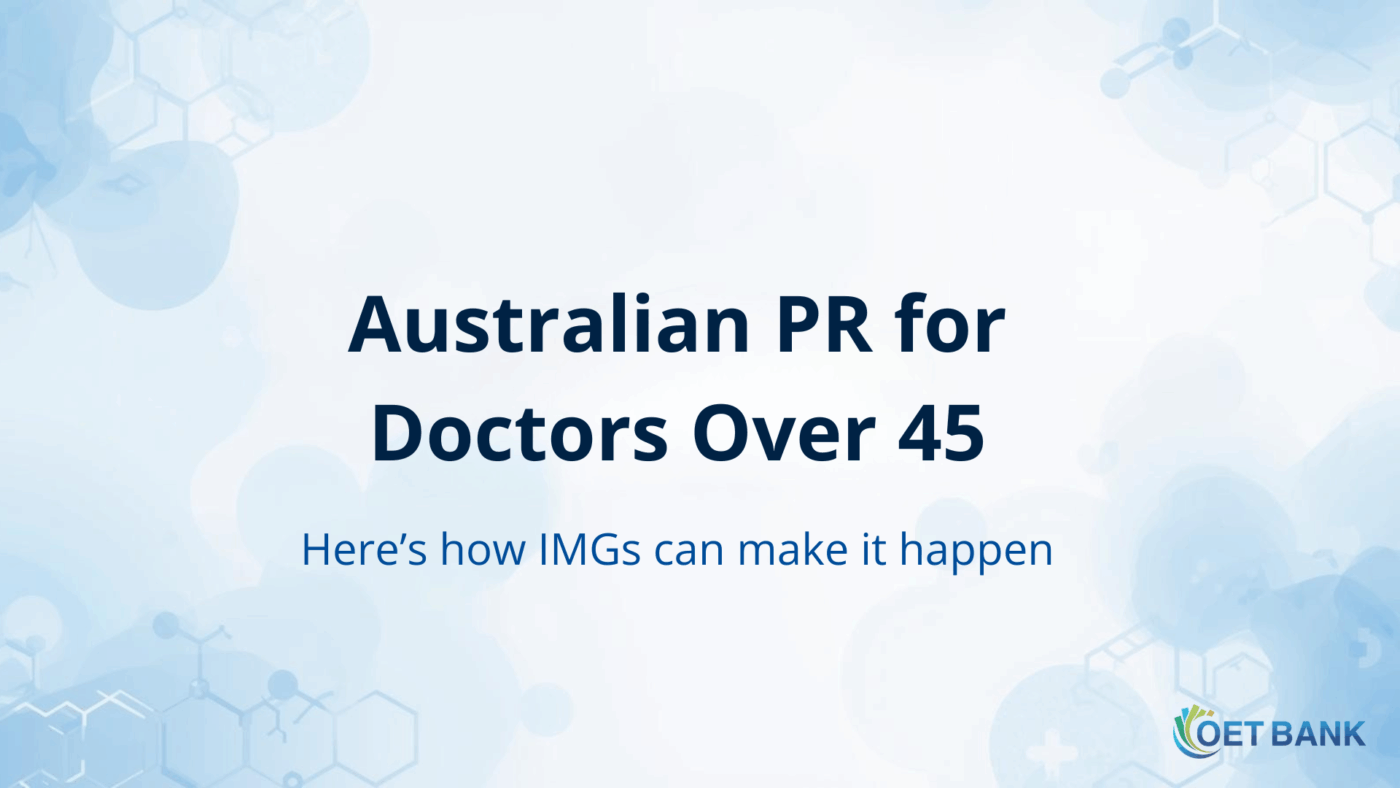Registration & Pathways
Australian PR for Doctors Over 45 Explained
In recent years, more and more physicians in their 40s and 50s have reached out with the same concern:
“Is it still possible for an overseas-trained doctor to get Australian Permanent Residency after age 45?”
It’s a reasonable question. Many countries set age limits for PR applications, and Australia is one of them—most general PR pathways require applicants to be under 45.
This rule applies even to doctors.
However, there are exceptions, and under specific conditions, IMGs (International Medical Graduates) over 45 can still apply for PR.
This article explains those pathways in detail.
PR for Doctors in Australia
To work clinically in Australia as an IMG, you must meet two core requirements:
- Provide acceptable English test results, and
- Obtain medical registration with AHPRA.
For English, you must pass one of the approved tests. Among IMGs, OET and IELTS are the most popular options.
A detailed comparison is available here:
https://oet-bank.com/oet-b-vs-ielts-7/
For medical registration, there are two main options:
- Standard Registration via passing the AMC exams, or
- Specialist Registration, which recognizes your specialist qualifications from overseas.
Once registered and employed, you can begin practicing.
Some IMGs—especially those who already hold a specialist qualification—may work under programs such as Short-Term Training in a Medical Specialty, which sometimes require only English test results upfront.
However, obtaining the right to work as a doctor and obtaining PR are two different processes.
Australia’s general PR system is points-based, and age under 45 is a key requirement.
Therefore, IMGs over 45 cannot apply through the standard points system.
Instead, there are three alternative pathways.
Let’s examine each.
Method 1 — Work as a Doctor in a Designated Regional Area
The first option is to work in a designated regional area of Australia.
The Subclass 186 (Employer Nomination Scheme) visa normally has a strict age limit.
However, a specific exemption exists: the “186 age exemptions.”
Here is the relevant section:
You are a medical practitioner (ANZSCO Minor Group 253) under the Temporary Residence Transition stream and you meet all of the below:
– You have worked in your nominated occupation while holding a TSS or subclass 457 visa for at least three years,
– At least two of those years were in regional Australia, and
– The nominated position is in regional Australia.
Source: 186-visa-exemptions
In short:
✔ Work as a doctor in Australia for 3 years, including
✔ 2 years in a designated regional area,
→ and you become eligible to apply for PR through the 186 exemption.
“Regional” excludes major cities such as Sydney, Melbourne, and Brisbane.
You can confirm exact postcodes through the official government site.
A crucial first step is securing an employer.
The most reliable method is to contact hospitals listed on your specialty college’s website.
If your specialty doesn’t publish hospital lists, you can contact the college directly and ask to be connected with hospitals that match your background.
Method 2 — Apply as a Business Owner (Practice Owner)
The second option is to apply as a business owner, typically suitable for IMGs who have owned or operated a clinic overseas.
This is done through the Subclass 188 Business Innovation visa.
Requirements include (example conditions):
- Demonstrated business turnover (e.g., around AUD 750k equivalent in your home country),
- Ownership share,
- Age under 55 in most cases,
- Meeting the threshold points through the immigration points test.
You can check details and calculate eligibility on the Department of Home Affairs website.
The 188 visa is issued for up to five years.
During those five years, you may transition to PR by:
- Employing two or more Australian workers, and
- Achieving specific business targets.
Even though this pathway involves establishing a practice, you still need Australian medical registration, which requires passing an approved English test and meeting AMC or specialist pathway requirements.
Method 3 — Apply as a Researcher (Global Talent Visa / 858)
The third pathway is the Global Talent Visa (Subclass 858).
This visa is for individuals who are globally recognized for exceptional achievements.
Many active clinicians apply under the “medical research” or “clinical research” categories.
Key features:
- Age limit: generally under 55,
- English requirement: as low as IELTS 4.5,
- Focus: evidence of international recognition and outstanding achievements.
You can check official details online, though the government provides limited specifics—meaning the outcome is uncertain until you apply.
In 2024, the number of places for the 858 visa was reduced by 1,000, and the stream is expected to transition to the National Innovation Visa.
The terminology is shifting from “global talent” to “most exceptional talent,” implying a stricter selection standard.
Even so, highly accomplished doctors or researchers may still be strong candidates.
Summary
Doctors over 45 still have realistic pathways to Australian permanent residency.
The three main options are:
- Work as a doctor in a designated regional area (186 age exemption),
- Apply as a business owner or clinic operator (188 pathway),
- Apply as a high-level researcher (858 / National Innovation Visa).
Australia’s PR system becomes significantly more difficult after age 40, especially through the general points test.
However, IMGs—due to their skills and professional demand—still have multiple routes available.
I hope this guide helps you evaluate which pathway fits your circumstances.
If you’re preparing for OET, consider exploring our practice resources at OET Bank.
We’re designed not just as mock tests, but as powerful review tools that make it easier to analyze weaknesses and focus on what’s needed to pass.
Explore professional learning materials and courses:
👉 https://oet-bank.com/shop


